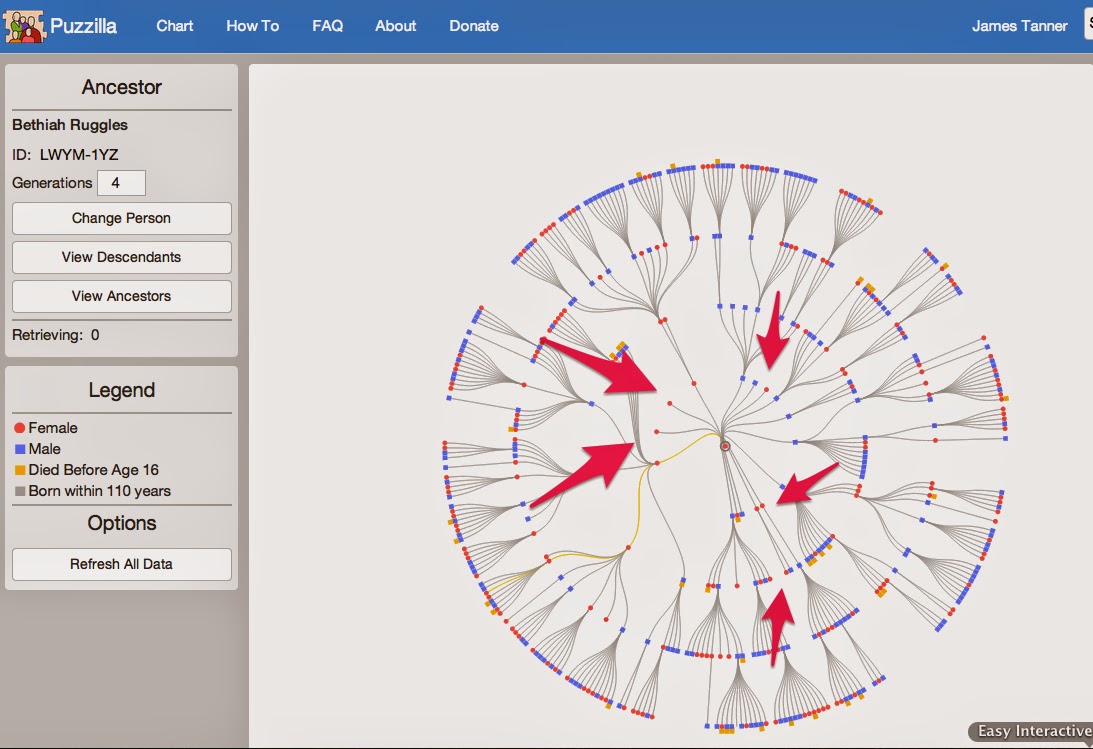I wasn’t being methodical, I admit, but in an hour, I didn’t find any descendants who hadn’t had their work done, sometimes more than once. I think I forgot to mention that I come from a family of really serious over achievers. It makes being normal pretty depressing. So I’m blaming all of these multiple ordinances on them. Anyway, the Puzzilla tree didn’t seem to have any unpicked fruit either.The Puzzilla.org program is a wonderful tool for pointing to individuals and families where more research needs to be done. Amy's post does a very good job of explaining how the program works. The comment illustrates two common misconceptions about the program.
Misconception No. One: The program will tell you what ordinances have been done and which haven not.
The program's purpose is to show the current status of the research. Of course, you could click on each individual and then use the link from that individual to go to FamilySearch.org Family Tree to see whether or not the Temple work has been done, but why do that? You can assume that anyone who shows up in Family Tree, with some very rare exceptions, has certainly had all of their Temple work done. If you want to spend your time looking for "green arrows" you will soon find that they do not indicate that the work has not been done, but merely point to places in the Family Tree where either more information is needed or individuals need to merged. So, the idea here is to go back before the first people in any given line joined The Church of Jesus Christ of Latter-day Saints. You go back to the person who joined the Church and then jump back one or two more generations before you start looking for descendants who need research.
Misconception No. Two: The Puzzilla.org program does not find "unpicked fruit."
The program shows what is not in Family Tree by showing what is already there. It appears that the commentator expected to find people who needed to have Temple work completed. As I said above, the program does not do that. What you look for is end of lines where more research is warranted. Let me illustrate what I mean from the Puzzilla.org program.
Here is a screenshot showing my family in Family Tree going back eight generations with an arrow showing the part of the tree where I am going to select an ancestor:
You can see from this image that a tremendous amount of information has been developed about almost all of my family lines. I am very much aware, after spending years and years, that everyone shown in this view has had all of their Temple work done. Now, I am going to select an ancestor. In this case I choose Bethiah Ruggles (1706 - 1776). Here is a screenshot of her descendancy chart:
The arrows point to individuals who have no, or very few, descendants shown in Family Tree. If I choose one of these, I immediately locate Bathsheba Morse who is listed as born on 28 Jan 1735 in Walpole, Norfolk, Mass. That's it. That's all the information shown. No death date. No spouse. This is a place where you could start doing research. That is what the program is supposed to do, not provide you with "low hanging fruit."
DANGER! WARNING!
Now there is a serious problem. FamilySearch.org Family Tree is presently still attached to the old New.FamilySearch.org program. Going this far back in my lines practically guarantees that there are problems with the pedigree. I presently cannot prove that the program has the correct line this far back. If you have the confidence that all the individuals as shown by your yellow line in Puzzilla.org are correct, then go ahead and start researching. Otherwise, you may just want to wait a little while longer until the program catches up with reality.













